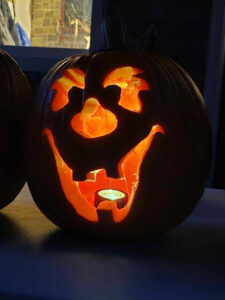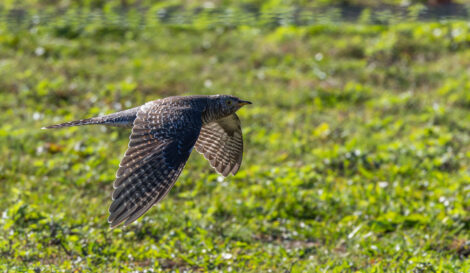A winter finch report for 2024-2025
- PHOTO BY WAYNE LAUBSCHER A male evening grosbeak enjoys a quick meal.
- PHOTO BY WAYNE LAUBSCHER A group of pine siskins flock to a feeder.
- PHOTO BY WAYNE LAUBSCHER A male purple finch rests on a tree limb.

PHOTO BY WAYNE LAUBSCHER A male evening grosbeak enjoys a quick meal.
It’s that time of year again. Fall migration is essentially over and, while we’ll miss most of the colorful bird species we enjoy in the spring and summer, there are a few arriving from northern latitudes and the boreal (northern) forest. These birds ought to get our attention and hold our interest for much of the winter.
Cone crops of several coniferous species which include pine, spruce, fir and tamarack are generally very good in western North America. White birch and mountain ash crops are also very good in the western regions. This will keep some species of northern finches out of our area. Some areas were affected by spruce budworms and tent caterpillars and those locations will have poor crops. Birds are moving out of those locations. The white pine cone crop that produced a major eruption of Red Crossbills last year is poor to absent this year.
Purple Finches usually move south each winter. A moderate flight of them has already been occurring since early fall. The Purple Finch is a species that nests in Pennsylvania. Males are washed in a colorful raspberry red and females are brown-streaked with a heavy face pattern. Their favorite food at feeders are black oil sunflower seeds.
A small flight Pine Siskins will occur south out of those areas that were affected by the aforementioned insect infestations. They are brown, usually with heavy streaking and some yellow in the tail and wings. They eat nyjer (thistle) seeds and black oil sunflower seeds in tube and sock feeders. Pine Siskins have been known to nest in Pennsylvania during irruption years.
That big, colorful, noisy and very hungry finch that bird watchers never tire of, the Evening Grosbeak, is returning to our region. Good crops of berries in the northern forests supported a good nesting season of Evening Grosbeaks. These crops, having been consumed by late summer, have resulted in a moderate flight occurring now. Males are gold and black with white wing patches and the females are gray and black also with white wing patches. They feed on large amounts of black oil sunflower seed at platform feeders.

PHOTO BY WAYNE LAUBSCHER A group of pine siskins flock to a feeder.
There are two additional non finch species making a good showing this fall and winter. They are included in the annual finch forecast. The first is a very familiar bird in our area year round. It is the unmistakable Blue Jay. A heavy flight of them is expected in their search for food.
Second, Red-breasted Nuthatches are coming through due to a lack of fir cone crops in some areas. They will be found in conifer stands. They have a black eye stripe with a white eyebrow and are bluish gray on the back with an orange underside. Their call sounds like a little tin horn.
Keep your feeders filled and hopefully these feathered visitors will help do away with the winter doldrums.
Thanks and acknowledgments to forecaster Tyler Hoar and the Finch Research Network. Go to: finchnetwork.org for more information.
— — — —

PHOTO BY WAYNE LAUBSCHER A male purple finch rests on a tree limb.
Wayne Laubscher recently retired from the Centre County Planning Office as Mosquito Disease Control Coordinator for Centre, Clinton and Clearfield Counties. He is the Clinton Co. compiler for the PA Birds publication, a member of the Lycoming Audubon Society board and a board member of the Pennsylvania Society for Ornithology. He is a native of the Lock Haven region, residing in Swissdale.
— — — —
BIRD LORE is produced by the Lycoming Audubon Society (serving Lycoming and Clinton Counties), Seven Mountains Audubon (serving Union, Snyder, Northumberland, Montour and Columbia Counties) and Tiadaghton Audubon Society (serving Tioga and Potter Counties). Information about these National Audubon Society chapters can be found at http://lycomingaudubon.blogspot.com and http://sevenmountainsaudubon.org and http://tiadaghtonaudubon.blogspot.com.





